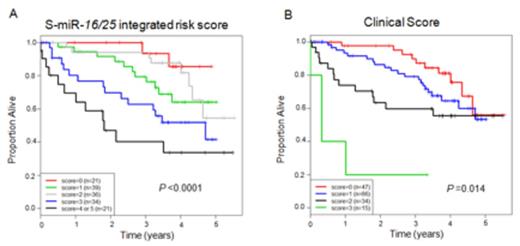Abstract
While international stage (ISS) and the presence of absence of cytogenetic abnormalities on FISH somewhat define the clinical risk of MM patients, additional biomarkers are necessary for more precise risk-based classification. Emerging studies have shown that circulating microRNAs (miRNAs) can be detected in patients with a variety of malignancies, including MM, and they could be non-invasive biomarkers. We measured serum miRNA levels of a large cohort of well-characterized previously untreated MM patients and correlated results with clinical outcome to test their prognostic impact.
Methods and Patients
To profile the expression of circulating microRNAs in the serum of MM patients, we performed NanoString-nCounter microRNA assays on samples obtained from a discovery cohort of 54 newly diagnosed MM patients enrolled on a randomized GIMEMA phase 3 study comparing Velcade-Melphalan-Prednisone-Thalidomide versus Velcade-Melphalan-Prednisone followed by maintenance with Velcade-Thalidomide. To further analyze the expression of the differentially expressed microRNAs, stem-loop-RT-PCR was performed on a validation cohort of 234 MM patients enrolled in the same trial. The prognostic significance of differentially expressed microRNAs were evaluated in relation to progression-free (PFS) and overall survival (OS) using univariate and multivariate Cox proportional hazards models. The utility of incorporating microRNA expression into a risk score with known risk factors – specifically ISS stage and the presence of del17, t(4;14) or t(14;16) by FISH – was also explored.
Out of the 800 miRNAs evaluated, only 25 were detectable (≥100 counts) in at least 20% of the patients. The expression of these miRNAs were then measured in a validation set, but only 10 (miRs-92a, 21, 30a, 720, 451, 223, 126, 19b, 25 and miR-16) were validated to be differentially expressed. We found that levels of miR-16 and miR-25, used as continuous variables, had significant impact on OS duration: miR-16 (HR 0.87; p=0.019) and miR-25 (HR 0.81; p=0.0012) where low expression corresponded with worse survival. Based on these observations we generated a microRNA-based risk score which was significantly associated with OS duration (p=0.008). We then integrated this score with ISS stage and presence of high risk features by FISH, generating an integrated-microRNA risk score that was significantly associated with OS (p<0.0001), and was better than a risk score that combined ISS and FISH (p=0.014), see figure.
Improved overall survival (OS) based on integrated serum miRNA risk score vs clinical risk score alone. (A) Based on the integrated S-miR-16/25 risk score for OS where the score reflects the sum of the following risk factors: ISS stage III, del17, male gender, low miR-16, or low miR-25. Only two patients had an integrated risk score of 5 they were incorporated with score 4. (B) Clinical score groups reflects the sum of the following risk factors: ISS stage III, del17, and male gender.
Improved overall survival (OS) based on integrated serum miRNA risk score vs clinical risk score alone. (A) Based on the integrated S-miR-16/25 risk score for OS where the score reflects the sum of the following risk factors: ISS stage III, del17, male gender, low miR-16, or low miR-25. Only two patients had an integrated risk score of 5 they were incorporated with score 4. (B) Clinical score groups reflects the sum of the following risk factors: ISS stage III, del17, and male gender.
Circulating miR-16 and miR-25 can risk stratify elderly, previously untreated, MM patients beyond ISS-stage and high risk genetic features. The opportunity to isolate circulating miRNAs allows us to sequentially sample cancer patients in a relatively non-invasive manner, opening new avenues of investigation for disease stratification and response to therapy.
Bringhen:Onyx: Consultancy.
Author notes
Asterisk with author names denotes non-ASH members.


This feature is available to Subscribers Only
Sign In or Create an Account Close Modal